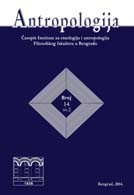ЈЕЗИЧКИ КРАЈОЛИК СРБИЈЕ (ПРВИ ДЕО): ПЕРЦЕПЦИЈА ПРИСУСТВА ЋИРИЛИЦЕ И ЛАТИНИЦЕ У ЈАВНОЈ СФЕРИ
THE LINGUISTIC LANDSCAPE OF SERBIA (PART ONE): PERCEPTIONS OF ALPHABET PRESENCE IN THE PUBLIC SPHERE
Author(s): Dejan IvkovićSubject(s): Anthropology, South Slavic Languages
Published by: Институт за етнологију и антропологију
Summary/Abstract: Digraphia – the use of more than one writing system by the same speech community for the same language – is perhaps the most intriguing feature related to the modern Serbian usage. The crux of the phenomenon lies in a repertoire of ways modalities of alphabet use are embedded in almost every pore of the quotidian life of a Serbian speaker, where the choice of one or the other alphabet is not arbitrary but rather motivated, depending on the function of language use. With consequences that stretch beyond a mere alphabet preference, the functional split affects perce ptions, attitudes and ultimately influences orthographic behavior, depending on the context of use (Ivković, 2013, 2015). The purpose of the study is to explore awareness of the speakers of Serbian about the presence of the Cyrillic and Latin alphabets in Serbia’s linguistic landscape, including traditional and new media. An online survey, with versions in both scripts, was conducted from November 2014 to January 2015. In total, 377 respondents, from different parts of Serbia, answered 32 multiple-choice questions examining associations between alphabet choice and a particular domain of language use: context, situation, agency or discourse. The respondents had the option to select one of the following answers: “I have associations mostly with Cyrillic,” “I have associations mostly with the Latin alphabet,” “I have associations with both alphabets, equally,” and “I have no such associations.” The respondents also had the option to write a comment expressing their thoughts on digraphia. The participants responded to survey calls distributed across various social media, including several webpages and forums of “Cyrillic activists,” that is, groups of citizens who advocate the use of Cyrillic as the only script in official use in Serbia. This group, constituting approximately one third of the respondents, comprise the Activist sub-corpus. The rest of the respondents comprise the Latin and Cyrillic sub-corpora, named after the alphabet they used to complete the survey, respectively. The results of the study indicate that there is awareness about the dominance of one or the other alphabet across different domains of use, with the Cyrillic alphabet primarily being associated with the context of use of the Serbian Orthodox Church, tradition, national identity, and rural Serbia, whilst the Latin alphabet is associated primarily with consumerism, pro-Western groups and policies, entertainment, urban contexts, and the Yugoslav era, as illustrated in the graphs showing the continua of digraphia and alphabet choice across domains of language use.
Journal: Antropologija
- Issue Year: 15/2015
- Issue No: 2
- Page Range: 87-110
- Page Count: 24
- Language: Serbian

